Soccer drills for
- On half the pitch and with a large goal, overtal is played out.
- The neutral players remain on the flank, but move about (offer).
- The defence can score on a small pupil goal when they catch the ball.
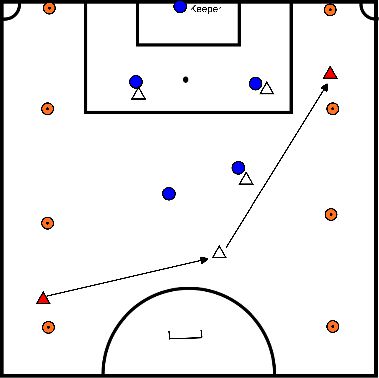
- The neutral players stand on the sideline.
- The game is played with pupil goals.
- Defenders can score directly after possession of the ball.
- Attackers must pass over X times.
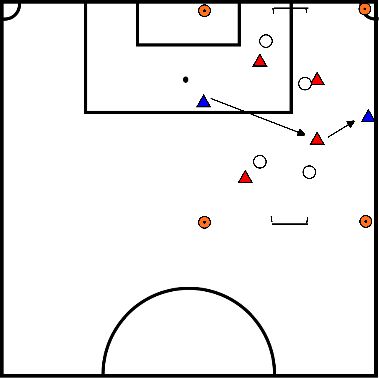
- 2 goalkeepers in goal.
- Defender passes ball to K1, defender runs free and gets ball, after which he looks for other goal and finishes on K2.
- Duration: 10 min.
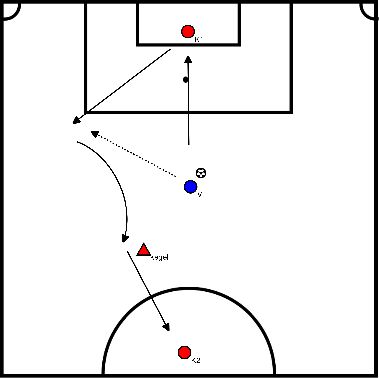
- Exercise double lining up.
- O1 plays in to O2.
- O2 plays long ball to K. K controls/catch ball and plays out the 3 on 2.
- When O1/O2 take ball they score at big goal with K .
- K + A1 and A2 score at small goal which O1/O2 defend.
- Duration:
- 15 min.
- Passing on :
- O1/O2 become A1/A2 and vice versa.
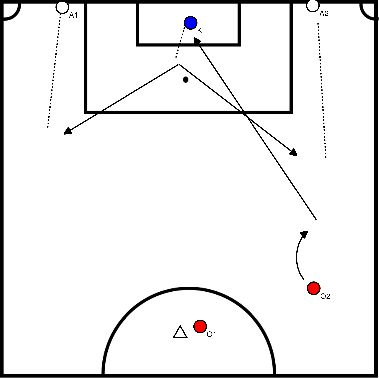
- Trainer kicks depth ball.
- K decides whether to come out or defend goal.
- Attacker tries to take ball away and score on goal.
- If goalkeeper has ball, 2 on off via O.
- Attacker takes ball with him and may not finish in 1 time.
- Line up twice (2 trainers).
- Duration 15 minutes.
- Upgrade 1 :
- Trainer chooses high ball.
- Upgrade 2 :
- 2 attackers instead of 1 (2 VS 2), attacker 2 may only join when goalkeeper can play.
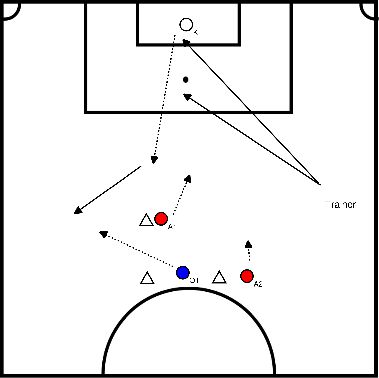
- Possibly double line up.
- 2 trainers.
- Duration 10 min.
- Goalkeeper 1 kicks out to goalkeeper 2 (long ball).
- Goalkeeper 2 controls and builds up attack via A1.
- A1 plays on opposite flank A2 .
- A1/A2 and goalkeeper 2 build on goal K1.
- Defenders join in.
- Passing attackers become defenders.
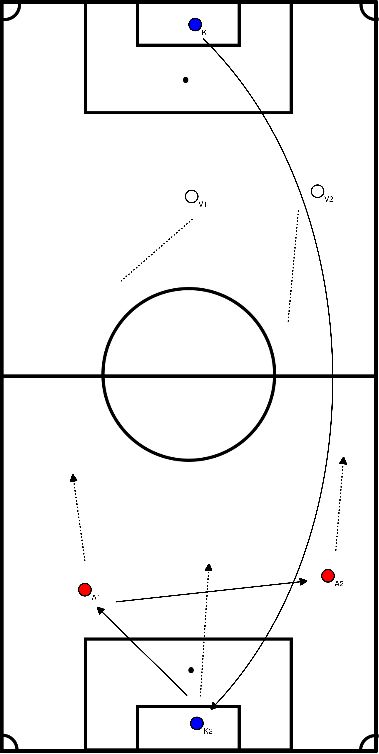
This exercise will improve the passing game. We also increase the difficulty by starting the same exercise at two sides. The passing has already been done for the U23 and U12 but can also be used for younger players.
It is a simple form which can be done in a space of 20m by 20m or smaller. If you want the pass line 3 to be longer and tighter, you have to draw it backwards.
A and D start the exercise together by passing to B and E (1), who then pass the ball back (2). A and D run in on the ball and play diagonally to C and F (3). Here, both players have to be careful not to bump into each other, so vista is important in passing. B and E turn around and ask a 1/2 from C and F (4,5). C and F guide the ball further to the starting position to start again (6). The players continue to advance according to the letter.
A-B-C-D-E-F-A.
You can always run this pass at a high tempo. If you have a younger age group which is a bit sluggish, then allow a ball control in the passing.
The fun aspect is always possible too. You place a small goal in the zone of A and D.C and F try to score a goal after the double pass. The one who scores the fastest is the winner.
This time we have put online a game form in which you play 4vs4 in the middle and each team has 2 more players in a neutral zone on the sides. This type of game has been practiced many times by our teams and first teams. With emphasis on fast passing and deep running.
Age category: U14 to U21 and first team.
This type of game can be played on a 15m x 30m pitch. This depends on the age of the players and the pressure they are under. If you want to play in this shorter space, make it smaller. Otherwise, make it bigger. The endzone is about 2 to 3 m deep.
In the middle you play 4vs4 and on both sides both teams have 2 players who have to play in 1 time.
The 4 middle players try to control the ball in the endzone, but the last pass must be made in 1 time.
As you can see on the picture, the ball is played in by the back player to the outfield player (1), who immediately passes (2). The middle player passes to the furthest player (3), and the furthest player looks for the 3rd man in between, who opens up in the deep (4). The latter then checks the endzone to score.
Like in the picture, you can also place fixed cones or dolls as an extra difficulty.
Of course you can increase the number of ball keys according to the age.
There are always extra rules that you can add. E.g. it should not be the 3rd man to score.
This type of game can be used perfectly in your periodization.
This is a technical football exercise in a pass and kick form.
Mark out a square of 15 by 15 meter.
Place three or four players at all yellow cones. If you have sixteen players or more, it is best to mark out two sections. The exercise starts with four players at the same time. All four players dribble to the blue pawn in the middle of the square. When they reach the blue pawn, they cut the ball off to the left or right.
The first player of pawn A passes to the second player of pawn B. He receives the ball and now it's his turn to dribble to the blue pawn and pass to the left or right.
Player A runs after the ball and thus joins the line at the pawn again, keeping the players in a circle. Make sure all players run in the same direction (left or right). After a while, you can switch between left and right.
Coach moments
The ball touches must be good, make sure the players move on their front feet and have an active position to catch the ball
Make sure that the cutting movement is exaggerated and that the ball is in a good position to be passed into.
The ball should be played in hard again and again, in order to keep up the pace and speed of the ball
The dribbling must also be done at a high speed, with the ball close to the foot.
Variants of this type of exercise: (can be performed with the left or right foot)
Cutting with the inside and outside of the foot
Pull back with the left and then turn open with the right
Step over with the left and then take the ball over with the right
Retrieve with the left and tap the ball with the right behind the supporting leg
Tips
Try out different sizes of box When you have a larger section, you are training for fitness and a tight ball When you have a smaller section, you are mainly training for speed of action
Work through this type of exercise in three to five-minute sessions
Try to ensure that the four players who are walking towards the blue cone start at about the same time
Make sure there are enough balls at pawns A and B.
You can do this exercise with six to eight players.
If you have enough players, you can make two squares.
Explanation soccer training
Player A plays the ball on the ground to his teammate at pawn C. The player at pawn B does the same to the player at pawn D.
The player at pawn C actively asks for the ball from the player at pawn A and then immediately plays it to the player at pawn F.
The player at pawn C first makes a pre-action and then asks for the ball from the player at pawn A, after this, he plays the ball directly to the player standing near pawn F. The player standing near pawn D does the same to the player near pawn C.
Player A and B have passed to Pawns E and F after the pass and are now defenders. The players at Pawns E and F turn away from players A and B who are now at their backs.
Players A and B, after their defensive action, run on to Pawns C and D. The players at Pawns C and D run on to Pawns E and F. The players who have turned away from their defender go to Pawns A and B.
Coaching moments
The ball speed must remain high, so the balls must be hit hard. This is best done over the ground at a short distance (15 to 20 metres) and through the air at a long distance (35 to 40 metres) At a distance of about 8 meters it is best to bounce the ball.
Make sure the players of pawns C, D, E and F have an active attitude and stand on their front feet. They really have to want the ball and must also make a front pass.
Make sure that, after turning in, the players turn open and place their bodies between the defenders and the ball They should also keep the ball close to them When they have opened up, a slight acceleration takes place
- In this game form we play eight against four.
- Do you have more or less players? You can also choose to play six against three, seven against three, seven against four, nine against four or nine against five.
- Make sure you adjust the dimensions of the field with more or less players.
- After five replays, the eight team may score
- The eight team can score after five replays.
- The team with four players can always score
- Every time the ball goes out, after a goal is scored or when the ball is intercepted by the foursome, start the count again.
- Swap after five goals or up to 10 minutes.
- You can adjust the difficulty by having them pass more or less often for a point.
Points of attention
- Correct ball speed
- The ball must be held low over the ground
- The left and right foot must be used
- Takeover with the right foot
- 6 players with the ball try to dribble to the opposite side without the defender(s) stealing the ball
- If the defender captures the ball and has the ball under control(ball under foot) or if the trio shoots the ballthey get 1 point
- when the defender scores 3 points, another defender comes on
size: depending on age and skill
- length: 20 metres
- width: 10-15 metresalways play this form in a rectangle







